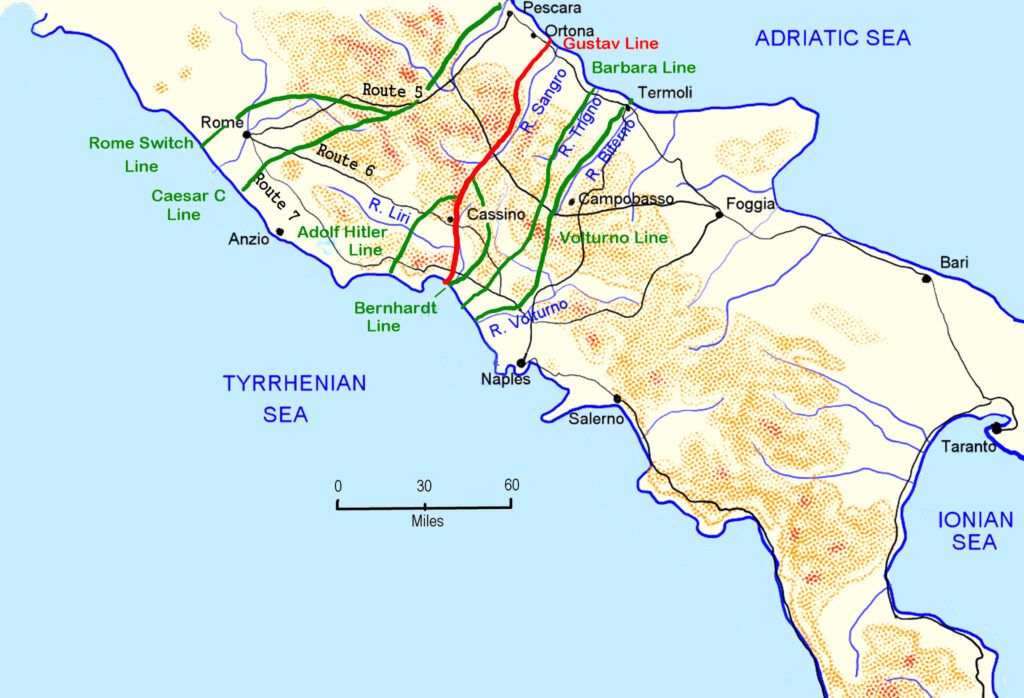
Bulletin #185 — Oct 2023
Deadlock 1943

Stephen Kirrage, CC BY-SA 3.0
September 23, 2023
Allied Progress in Italy Stalled 80 Years Ago
Following a swift campaign that seized control of Sicily in the summer of 1943, Anglo-American forces were landed in southern Italy in early September. By 1 October they had reached Naples. Across the peninsula, Termoli was captured on the Adriatic coast two days later. Soon, however the Allied advance stalled due to strategic decisions taken on both sides of the fighting, as Winston Churchill explained in Chapter 14 of Closing the Ring, the fourth volume of his war memoirs.
Early in October, on [Field Marshal Albert] Kesselring’s advice, Hitler changed his mind about his Italian strategy. Till then he had meant to withdraw his forces behind Rome and hold only Northern Italy. Now he ordered them to fight as far south as possible. The line selected, the so-called ‘Winterstellung,’ ran behind the river Sangro, on the Adriatic side, across the mountainous spine of Italy, to the mouth of the Gargliano on the west. The natural features of the country, its steep mountains and swift rivers, made this position, several miles in depth, immensely strong. After a year of almost continuous retreat in Africa, Sicily, and Italy the German troops were glad to turn about and fight.
Although the approach of winter would seriously impede our actions, the main strategic decisions taken at [the Allied conference that summer in] Quebec were helped by the Germans committing themselves so deeply. The primacy accorded to our cross-Channel invasion made Italy henceforward a secondary theatre. That Hitler felt impelled to use so many troops to resist our advance favoured our major objective, but did not justify our making a failure of the Italian campaign.
The Fifth Army resumed their attacks on October 12, and after a ten days’ struggle both its corps, the Xth British and VIth American, were well established across the river Volturno and ready to engage the enemy’s next delaying position, a series of heights lying south of the river Gargliano. Another week of fighting was needed to eject the enemy from these, but in the first fortnight in November the Army came to grips with the forward defences of the ‘Winterstellung.’ On this front the Fifth Army, of six divisions, was faced by an equal number of Germans, who were fighting with their usual stubbornness.

2025 International Churchill Conference
The first probing efforts at the German line met with little success. Our men had been fighting hard for two months, the weather was shocking, and the troops needed rest and re-grouping. Nevertheless the plans made at Quebec for a different situation were rigidly enforced, and the Mediterranean was to be largely stripped of landing-craft.
Thus the position in Italy was changed greatly to our disadvantage. The Germans were strongly reinforced and ordered to resist instead of to withdraw. The Allies, on the contrary, were sending eight of their best divisions from Italy and the Mediterranean back to England for the cross-Channel attack in 1944. The four extra divisions I was gathering or had sent did not repair the loss. A deadlock supervened, and was not relieved during [the] eight months of severe fighting [that followed].
Subscribe
WANT MORE?
Get the Churchill Bulletin delivered to your inbox once a month.





